|
Hasegawa's 1/48 scale
B5N2 Type 97 (Kate) Model 3
by
Bruce Salmon
|
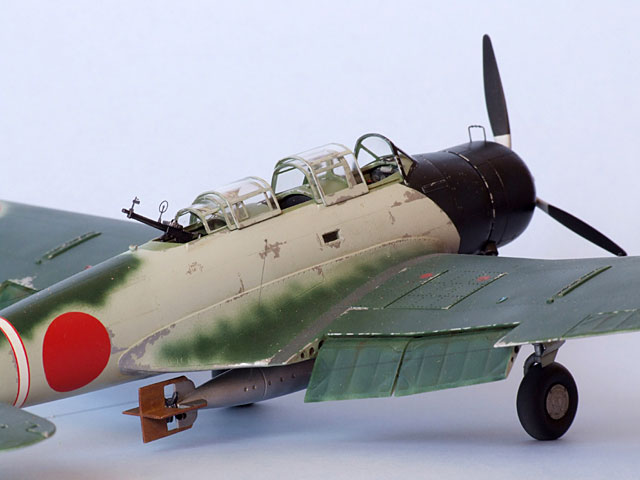 |
|
B5N2 Type 97 (Kate)
|

Hasegawa's 1/48 scale
Kate is available online from
Squadron
This aircraft is part of the “Pearl Harbour Trio” that I wanted for my
WW2 Pacific collection.
Unfortunately I should have used Ame-Iro as the underside colour, an
aerial mast configuration and an 800Kg bomb to make it accurate. If only
I had followed the kit camouflage scheme instead of trying to make
something a bit different.
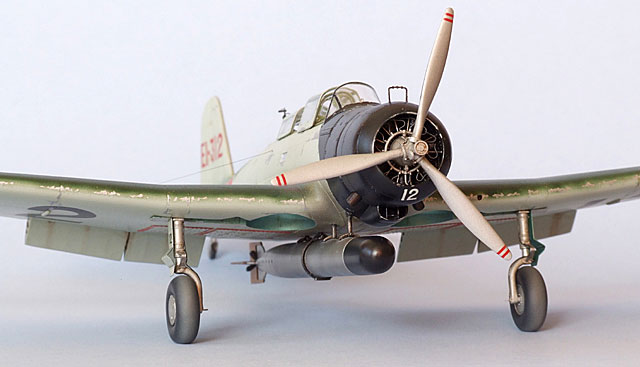
Therefore it has be relegated to a battle of lesser fame; an aircraft
from the carrier Shokaku – Battle of the Coral Sea - 8 May 1942.
Aftermarket Products Used:
Eduard PE set (48 363) B5N Kate
Engine and Cowling
The engine was detailed with the PE, painted matt black, weathered
with oils, drybrushed with Humbrol H11 Silver and set aside for final
assembly.
Cockpit / Fuselage
Most of the PE is destined for the cockpit and looks great after
painting and weathering. All the kit parts fit well.
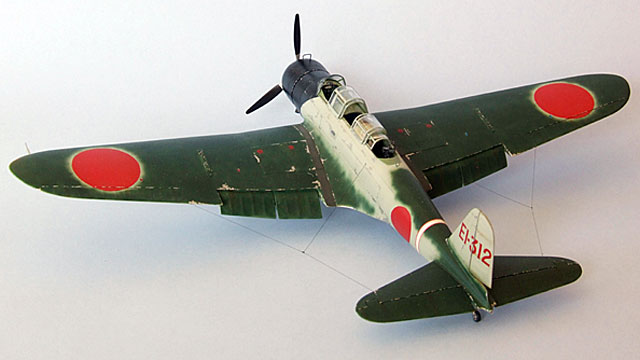
The rudder and elevators were cut out and repositioned to add life to
the model.
Wings
Wings go together well and fit to the fuselage with no problems. The
flaps had lightening holes drilled which will be seen when they are set
in the lowered position.
Detail Parts
Main wheels were given the PE treatment, brake lines and then
painted. A light spray with Tamiya XF57 Buff on the tyres simulates
grime and wear.
The torpedo needed scratchbuilt wooden fins added and was then sprayed
Tamiya XF16 Flat Aluminium with a random light flick with X19 Smoke to
give it a more realistic appearance and a black warhead.
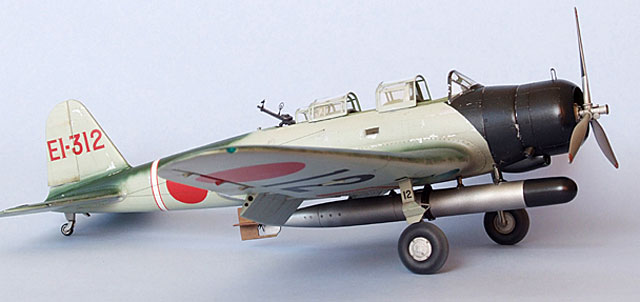
Canopy parts were thinned around their edges to make them more to scale
then masked using bare metal foil and set aside for painting.
The closed canopy provided in the kit was used to mask the interior
before painting began.
Firstly the wheel wells were painted and masked then an all over coat
of the lower surface colour was applied. Hinomarus were masked and
sprayed making sure to keep the masking circle centres to protect the
Hinomarus while the upper green was oversprayed in a cloudy pattern.
Next the fuselage stripe was masked and painted followed by the
cowling black colour and walkways.
Paints used are as follows:
-
Interior: 9 - Tamiya XF71 Japanese
Interior Green / 1 – Tamiya XF2 White
-
Upper Green: 8 - Tamiya XF11 JN Green
/ 1 - Humbrol 226 Interior Green / 1 – Tamiya XF2 White
-
Lower Surface: 8 – Tamiya XF12 JN
Grey / 2 – Tamiya XF2 White
-
Cowling: 1 – Tamiya X2 Royal Blue / 2
– Tamiya XF1 Black
-
Hinomaru: 6 – Humbrol 153 Insignia
Red / 1 – Humbrol 113 Rust
-
Wheel Wells Aodaki Blue: 1 – Tamiya
X23 Clear Blue / 1 – Tamiya X25 Clear Green over Tamiya XF16 Flat
Aluminium
-
Walkways: 2 – Tamiya XF63 German Grey
/ 1 – Humbrol 110 Natural Wood
-
Exhaust Pipes: 2 – Tamiya XF2 Black /
1 – Humbrol 113 Rust
Decals
The only decals used are the tail codes, underwing and cowl/gear door
numbers; everything else was masked and painted. The underwing numbers
did not conform well to the hinges so they were trimmed with a knife and
the missing patches painted black. Japanese aircraft are good for this
kind of thing because if a decal gets damaged or masking tape pulls up
some of your paintwork all you have to do is brush on some aluminium to
look like paint chipping and you are saved hours of reconstruction and
anguish.
Weathering
After a coat of satin varnish the model was given an overall wash
with raw umber oil with some panel lines darkened with further washes
where black was added. A few oil stains were drybrushed and some
chipping applied with Tamiya XF16 Flat Aluminium and a fine brush.
Exhaust staining was with Tamiya X19 Smoke. A matt-ish varnish was then
sprayed to finish the job.
Final Assembly
All the breakables are now added in order of least likely to get
knocked off goes on first:
Engine and cowl, flaps, torpedo, landing gear PE doors, observation
windows, rear machine gun, canopy, cowl sight, propeller, aerial wires.
The completed model certainly “looks the business” when carrying a
torpedo. Aside from the wooden fins that the kit missed out on there are
no other real issues with construction.
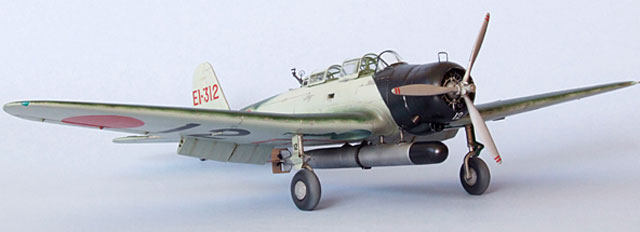
The Kate is a nice addition to any modeller’s cabinet.
Model, Images and Text Copyright © 2007
by Bruce Salmon
Page Created 06 December, 2007
Last Updated
24 December, 2007
Back to
HyperScale Main Page
|
Home
| What's New |
Features |
Gallery |
Reviews |
Reference |
Forum |